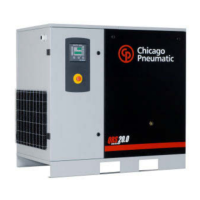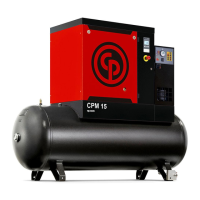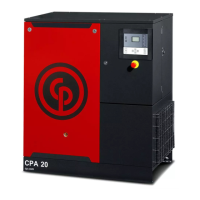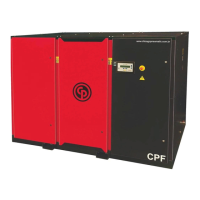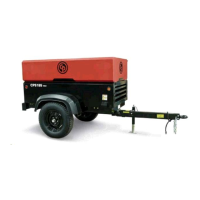Do you have a question about the Chicago Pneumatic QRS 10 and is the answer not in the manual?
Explains warning and informational symbols used throughout the manual.
General safety rules for operation, maintenance, and repair of the compressor.
Guidelines for safe installation of the compressor unit and its environment.
Essential safety measures for safe operation of the compressor.
Critical safety steps for performing maintenance and repair tasks on the unit.
Overview of the QRS 10, QRS 15, QRSM 20 series air-cooled compressors.
Illustrates the path of air and oil through the compressor system.
Details the lubricating and cooling oil circulation within the compressor unit.
Describes the components and function of the compressor's cooling system.
Explains components controlling compressor operation, pressure, and load/unload cycles.
Identification and function of controls and indicators on the main control panel.
Overview of the main electrical components and their layout within the compressor.
Details the safety valves and other mechanisms protecting the compressor.
Explanation of the air dryer's function in removing moisture from compressed air.
Introduction to the controller's role in operating, protecting, and monitoring the compressor.
Description of the buttons, display, and indicators on the controller panel.
Explanation of symbols and icons displayed on the controller for status and warnings.
Details the default screen displayed upon startup, showing status and pressure.
Instructions for starting, stopping, and managing the compressor's main functions.
Explains events triggering a shutdown warning, such as high outlet temperature.
Details conditions causing compressor shutdown, including temperature and motor overload.
Indicates when scheduled maintenance is due based on the service timer readings.
Guide to navigating the controller's menu structure and accessing parameters.
Procedure to display the total operating hours of the compressor.
Procedure to check the number of times the compressor motor has started.
Procedure to display the operating hours of specific compressor modules.
Procedure to display hours the compressor spent in loaded operation.
Procedure to view the number of loading actions for the solenoid valve.
Procedure for viewing and resetting the compressor's service timer.
Procedure to select and modify pressure bands for compressor regulation.
Adjusting load and unload pressure values for specific pressure bands.
Procedure to change the display unit for temperature measurements (°C or °F).
Procedure to change the display unit for pressure measurements (bar, psi, MPa).
Procedure to configure the duration the controller backlight remains active.
Enabling and configuring the compressor's automatic restart after power failure.
Procedure to lock and unlock the controller's keypad to prevent accidental changes.
Recommendations for compressor placement, environmental considerations, and initial setup.
References to dimension drawings and explanations of labels on the compressor unit.
Instructions for safely connecting the compressor to the electrical power supply.
Explanation of the various pictographs and labels found on the compressor unit.
Step-by-step guide for the initial start-up of the compressor.
Detailed instructions on how to start the compressor for normal operation.
Procedures for safely stopping the compressor during normal operation.
Steps for safely decommissioning the compressor for extended periods.
Overview of scheduled maintenance tasks, intervals, and procedures.
Information on the type of oil suitable and recommended for the compressor.
Procedure for replacing the oil, oil filter, and separator element.
Guidance on protective measures for storing the compressor after installation.
Information on available service kits for maintenance and overhauling the compressor.
Environmentally sound disposal methods for used parts and materials, including electronics.
Step-by-step guide for replacing the air filter element.
Instructions for cleaning the oil cooler to maintain optimal cooling efficiency.
Procedure for testing the safety valve's functionality and integrity.
Procedure for replacing and adjusting the tension of the drive belts.
Guidelines for selecting appropriate electrical cable sizes based on voltage and current.
Specifications for setting overload relays and selecting appropriate fuses.
Standard operating conditions and limitations for compressor performance.
Technical specifications for different compressor models and variants.
Safety and operational guidelines for the oil separator vessel.
Guidelines for the safe use and maintenance of the air receiver.
Information on the Declaration of Conformity and applicable legal requirements.
Explains warning and informational symbols used throughout the manual.
General safety rules for operation, maintenance, and repair of the compressor.
Guidelines for safe installation of the compressor unit and its environment.
Essential safety measures for safe operation of the compressor.
Critical safety steps for performing maintenance and repair tasks on the unit.
Overview of the QRS 10, QRS 15, QRSM 20 series air-cooled compressors.
Illustrates the path of air and oil through the compressor system.
Details the lubricating and cooling oil circulation within the compressor unit.
Describes the components and function of the compressor's cooling system.
Explains components controlling compressor operation, pressure, and load/unload cycles.
Identification and function of controls and indicators on the main control panel.
Overview of the main electrical components and their layout within the compressor.
Details the safety valves and other mechanisms protecting the compressor.
Explanation of the air dryer's function in removing moisture from compressed air.
Introduction to the controller's role in operating, protecting, and monitoring the compressor.
Description of the buttons, display, and indicators on the controller panel.
Explanation of symbols and icons displayed on the controller for status and warnings.
Details the default screen displayed upon startup, showing status and pressure.
Instructions for starting, stopping, and managing the compressor's main functions.
Explains events triggering a shutdown warning, such as high outlet temperature.
Details conditions causing compressor shutdown, including temperature and motor overload.
Indicates when scheduled maintenance is due based on the service timer readings.
Guide to navigating the controller's menu structure and accessing parameters.
Procedure to display the total operating hours of the compressor.
Procedure to check the number of times the compressor motor has started.
Procedure to display the operating hours of specific compressor modules.
Procedure to display hours the compressor spent in loaded operation.
Procedure to view the number of loading actions for the solenoid valve.
Procedure for viewing and resetting the compressor's service timer.
Procedure to select and modify pressure bands for compressor regulation.
Adjusting load and unload pressure values for specific pressure bands.
Procedure to change the display unit for temperature measurements (°C or °F).
Procedure to change the display unit for pressure measurements (bar, psi, MPa).
Procedure to configure the duration the controller backlight remains active.
Enabling and configuring the compressor's automatic restart after power failure.
Procedure to lock and unlock the controller's keypad to prevent accidental changes.
Recommendations for compressor placement, environmental considerations, and initial setup.
References to dimension drawings and explanations of labels on the compressor unit.
Instructions for safely connecting the compressor to the electrical power supply.
Explanation of the various pictographs and labels found on the compressor unit.
Step-by-step guide for the initial start-up of the compressor.
Detailed instructions on how to start the compressor for normal operation.
Procedures for safely stopping the compressor during normal operation.
Steps for safely decommissioning the compressor for extended periods.
Overview of scheduled maintenance tasks, intervals, and procedures.
Information on the type of oil suitable and recommended for the compressor.
Procedure for replacing the oil, oil filter, and separator element.
Guidance on protective measures for storing the compressor after installation.
Information on available service kits for maintenance and overhauling the compressor.
Environmentally sound disposal methods for used parts and materials, including electronics.
Step-by-step guide for replacing the air filter element.
Instructions for cleaning the oil cooler to maintain optimal cooling efficiency.
Procedure for testing the safety valve's functionality and integrity.
Procedure for replacing and adjusting the tension of the drive belts.
Guidelines for selecting appropriate electrical cable sizes based on voltage and current.
Specifications for setting overload relays and selecting appropriate fuses.
Standard operating conditions and limitations for compressor performance.
Technical specifications for different compressor models and variants.
Safety and operational guidelines for the oil separator vessel.
Guidelines for the safe use and maintenance of the air receiver.
Information on the Declaration of Conformity and applicable legal requirements.
| Brand | Chicago Pneumatic |
|---|---|
| Model | QRS 10 |
| Category | Air Compressor |
| Language | English |

